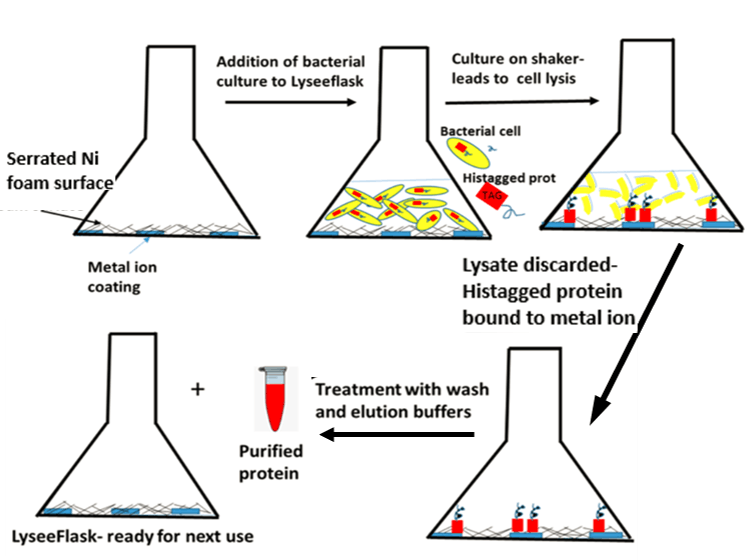Lysis of cells over-expressing proteins of interest by sonication is very often the first step in standard protein purification protocols. While it is a preferred method, it necessitates the presence of a sonicator, and this method of lysis could occasionally lead to denaturation of proteins. Here, we are proposing to make a flask called ‘LyseeFlask’ with a serrated metallic surface. Bacterial cells suspended in liquid media/ buffer,when shaken in our LyseeFlask in a regular incubator-shaker would be lysed owing to friction with the sharp edges on the surface. Since the use of immobilized ion affinity chromatography is one of the most commonly adopted strategies to purify proteins by tagging them with ‘Histags’, we have decided to incorporate metal ions on serrated surface. This would help the histagged-protein leaching out of lysed cells bind the immobilized metal ions. When maximal lysis has been achieved, the contents of the flask could be discarded, leaving behind the histagged-proteins bound to the metal ions immobilized on the metallic serrated surface. The protein of interest could be eluted from the flask with further processing by treatment with suitable buffers containing imidazole. The flask will be reusable following sterilisation and regeneration of metal ions.
Advantages of using LyseeFlask:
a) Minimizes the need for high-wattage equipment like sonicators, French press and centrifuges.
b) Reducing the usage of plastic ware and glass ware makes it a ‘greener option’.
c) The method is amenable to high-throughput production of purified proteins.
The generation of serrated surface: After toying with the idea of producing a serrated glass surface, we decided that it might be more feasible to use a metallic surface. We decided to use Ni foams to lyse cells. We were inclined to head in the direction of using Ni metallic foams after reading previously published work which used Ni-Nitrilotriacetate (NTA) immoblization on TEM grids (Benjamin CJ et al., Scientific reports, 6:32500; Kelly FD et al., J Mol Biol. 2008).
We established that Ni foams when used with cell suspensions (from 200 mL cultures) on a vortexer (0.5 cm Ni foams used with vortexer at 1000 rpm - 15 sec pulses given intermittently for a total of 3 minutes), accomplishes cell lysis comparable to that achieved with a sonicator. The cells lysed were E.coli BL21-DE3 carrying a plasmid overexpressing a Histagged protein of 18 kDa mass. We found that the protein from the lysate was able to bind Ni-NTA-agarose beads. The SDS-gel electrophoresis picture establishing lysis is below.
We then established a colloboration with two Materials Science engineers at IIT Bombay, India- Poorwa Gore and Aasiya Shaikh, in the third week of September. They have been able to activate Ni strips with NTA, and then charge the NTA with Ni2+ ions. The Autolab electrochemical working station was used to activate Ni strip. The activated Ni strip was then treated with NTA solution for 12 hours. The resulting Ni-NTA strip was treated with 50 mM nickel sulphate solution to charge the Ni-NTA with Ni(II) ions.
Our next step is to have the Ni foams of sizes corresponding to that of flask radii (10 cm in diameter) activated with NTA. Since Ni foams are malleable, following charging with Ni-NTA, these foams could be squeezed into the flasks containing cultures. This would transform a regular flask to 'LyseeFlask'.







Comments
Please log in or sign up to comment.